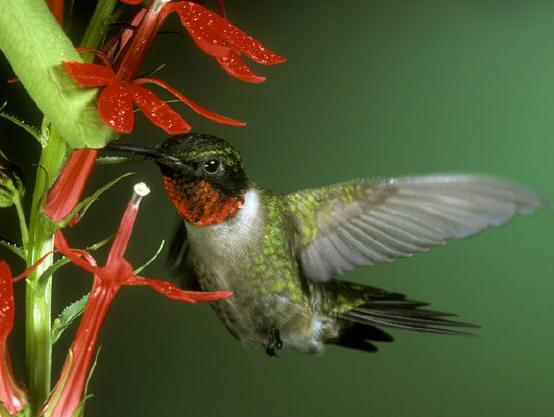Hummingbirds are the smallest and one of the most entertaining birds. Their tiny stature and extra long beak make them very recognizable. They have the ability to hover in one spot, dart extremely fast, up to 34 mph, and actually fly backwards. They flap their wings so quickly that they create a humming sound, hence, their name. When I am working in my garden, I
usually hear them before I see them. To me, it sounds like a little motor.
There are actually well over a hundred different species of hummingbirds, but the only species that we see in our area is the Ruby Throat. They winter in Central America and Mexico, but they come north to mate and raise their young. They migrate in the spring following the early blooms and arrive here sometime in April or early May depending on the weather.
Our Ruby Throat Hummingbird is a very interesting little character. Both male and female have beautiful, shiny emerald green backs, and silver/white breasts. You can tell the male because he has a red throat. The female and the young have a white throat. The female is slightly larger than the male, and she does all the work of building the nest and feeding the young.

She builds a nest that is about the size of a U.S. quarter. She uses spider silk which gives it flexibility so it can actually stretch as the babies grow. Then she lays two eggs, each the size of a pea. When her babies hatch, she feeds them tiny insects and small spiders.
Except for the brief mating period and the short time the mother cares for her young, the hummingbirds are very solitary birds. Unlike other species, they do not flock together. They even migrate separately. The male leaves first in the early fall, then the females, and finally the babies.
All hummingbirds drink the nectar from tubular flowers. They insert their extremely long beak into a flower and absorb the liquid using their extremely long tongues. They are especially attracted to the color red but will go to other colors as well.
If you are looking to attract them, you will want some early blooming plants that they will be able to use when they first arrive. After that, your goal is to keep a constant supply of suitable nectar flowers blooming all season so they will take up permanent residence in your garden. Hummingbirds are some of the smartest birds and have a very good memory. They will
usually return to the same garden year after year, sometimes using the same nest.
Early Blooms for the First Arrivals
Returning hummingbirds usually rely on trees and shrubs that generally bloom long before the perennials. Some of their favorite trees are crabapple, magnolia, flowering dogwood, flowering quince, red buckeye, and eastern redbud. Early shrubs loved by the hummingbirds are red azalea and weigela. Columbine and native Honeysuckle are two good perennial nectar choices.
Hummingbird Feeders
Hummers love sugar water (mix it one part sugar to four parts water). Set it out in early April so when the earliest birds arrive, it will be ready. If you have a good supply of hummingbird-attractive plants in your garden, it's probably not necessary to fill the feeders all summer, but the feeders make it easier to watch them and guarantee a constant food source which
these birds need. Hummingbirds are very territorial, and a male will spend most of the day guarding his feeder. It's quite entertaining to watch. Caution: Keep the water fresh. Sugar water will quickly develop bacteria which can make the birds sick if not changed regularly. Just set out a little at a time and preserve the rest in your refrigerator.
Other Great Perennial Choices
Agastache (Anise Hyssop), Delphinium, Foxglove, Gaura, Golden Rod, Hibiscus, Hollyhock (A Host Plant for the Painted Lady Butterfly), Joe-pye Weed, Liatris. (Also Called Gay Feather and Blazing Star). Lupine, Maltese Cross, Monarda, Penstemon (Try 'Dark Towers', 'Red Riding Hood' or 'Red Rocks'), and Salvia.
Value of Annuals
Hummingbirds are attracted to many annuals. One of their favorites is fuchsia. If you happen to have a shaded front porch, buy a fuchsia in a hanging basket. It is absolutely gorgeous, and the hummingbirds love it.
They really enjoy a wide variety of annuals. Remember to look for tubular flowers. The downside of annuals is the expense of buying them each year. However, many of the plants we think of as annuals are actually perennials in warmer climates. Unlike true annuals which only live for one season, these tender perennials can often be kept as houseplants all winter and
returned to the garden in the spring. Lantana and begonia, both loved by hummingbirds, are two good examples. I keep mine in lightweight pots that I can carry inside in the fall after I have cut the plants back. Several hummingbird-attracting annuals such as nasturtiums, zinnia, and flowering tobacco (nicotiana) are very easy to grow from seed planted directly in the
soil, thus reducing the cost of purchasing the plants.
Think Twice about Using Pesticides
Hummingbirds need spider silk to build their nests, and they rely on eating small insects and feeding them to their young. Destroying those insects will keep the Hummingbirds (and other birds) away.
Finally, Don’t Forget the Important Need for Water
A normal bird bath is way too deep for a hummingbird. Hummingbirds actually receive most of the liquid they need from the flower nectar. They do need fresh water to clean their feathers and will often bathe in wet leaves following a rain. They really like misters and bubblers which can be found at most garden centers.